#400 west rich
Text


DJBC Holiday Tumblr 22 - The Holidays in Franklinton




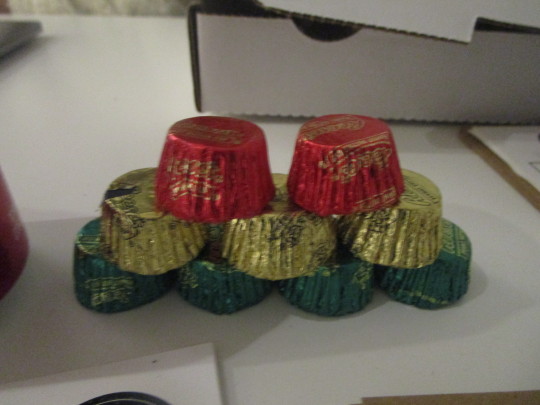


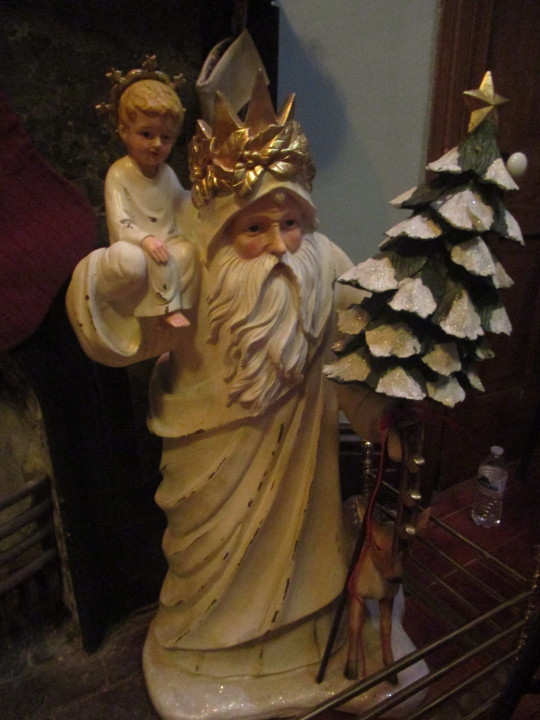






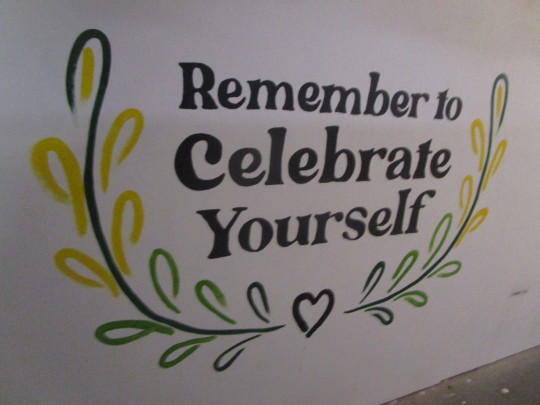


We slapped together highlights from the November and December Franklinton Fridays, Festivus, and Songs on Sullivant, and an Open House at the Historic Harrison House as highlights from the Holidays in Columbus's oldest neighborhood, which celebrated its 225th birthday in 2022.
#franklinton#franklintennial#broad street#sullivant avenue#400 square#400 west rich#franklinton arts district#djbcht22#national road#festivus
0 notes
Text
The Osun-Osogbo Sacred Grove is a UNESCO World Heritage Site in Nigeria, encapsulating 75 hectares of Yoruba cultural richness. Dedicated to Osun, the goddess of fertility, this sanctuary boasts around 40 shrines, ancient sculptures, and the meandering Osun River. The annual Osun-Osogbo Festival adds a burst of color, drawing pilgrims and tourists to witness the sacred rituals.
Beyond spirituality, it's a conservation triumph. Threatened by encroachment, the Osun-Osogbo Sacred Grove Conservation Foundation and the Osun State Government joined hands. Now, this haven, with over 400 plant species, including medicinal ones, stands as the last bastion of Nigeria's primary high forests.
The blend of ancient traditions and 20th-century sculptures makes it a symbol of Yoruba identity, connecting past, present, and future. Discover the herbal pharmacy, witness the vibrant Osun River rituals, and join the global effort to preserve this timeless symbol of cultural resilience and natural beauty.
35 notes
·
View notes
Text
Just gonna go ahead and say it. Since so many people are missing the nuance.
The reason so many Western powers do nothing to stop Israel is because it means admitting their own antisemitism was a driving force behind Israel's very creation.
Literally every country/kingdom/empire in which the Jewish people have lived, throughout history, has villified them and tried to kill them, cast them out or some combination of both. The very reason there are Jewish people across Europe is because the Roman empire found them to be too hard to manage in large numbers as they did not respect Roman authority. So the Diaspora or "dispersement" happened repeatedly and the middle eastern Jewish population was spread across Europe as far west as the UK and as far east as Russia.
Antisemitism was running rampant in the UK, the US and many other places before Hitler came along. The very reason that there is a stereotype about Jewish bankers, is because for a very long time (particularly in England) they weren't allowed to work most jobs in most fields. Their options were limited, and lending (not borrowing) money is not allowed by the Roman Catholic Church, which ruled over England from the 6th century to 1534. A thousand years of being a nation's only bankers is going to make you rich, but when times got hard economically, the British began to default on their debts and the stereotype of the "greedy jew" was born from this.
Antisemitism is thousands of years old and the aforementioned countries and others were looking for a way to deal with this "problem" and the idea of giving them their own country to go live in. So they leave yours, was presented and initially rejected, until Hitler came along. What the Nazis did allowed for this idea to move forward, now with the entire world feeling sympathetic to the horrors the Jewish people endured under their occupation.
Uganda was actually the original site planned in 1905, but their government and WHITE settlers their fought tooth and nail until another site was chosen, Palestine.
People seem to think Israel has always existed, but that is simply not the case. The word Palestine derives from Philistia, the name given by Greek writers to the land of the Philistines who in the 12th century BCE occupied a small pocket of land on the southern coast, between modern Tel-Aviv-Yafo and Gaza. The name was revived by the Romans in the 2nd century CE in “Syria Palaestina,” designating the southern portion of the province of Syria, and made its way thence into Arabic, where it has been used to describe the region at least since the early Islamic era. The Romans literally wiped Judea off the map, reduced it to rubble, before renaming it, and it stayed that way for the next 400 years.
Around 30% of the Palestinian population was already Jewish and living in relative peace before 1948. They could've easily increased their numbers without drawing new borders, but the Jewish lead British government (the Rothschilds and others already had their hands in everyone's pockets at this point) made it clear in 1917 with the Balfour declaration, that they intended to take Palestine from the Ottoman empire during WW1, and designate it the Jewish homeland. Actually, as soon as the war kicked off, British War Cabinet member and zionist Herbert Samuel proposed the government express support for zionist ambitions in order to gain more Jewish support (money and soldiers) for the ongoing world war. This effort continued through to WW2, finally gaining global support upon the world's realization of Hitler's atrocities.
This situation is anything but black and white.
23 notes
·
View notes
Text
i love being southeast asian.
despite whatever unhappy history, despite the rise of ethnonationalism and racism in our countries; despite the fact that most of us remain in the global south under the invisible thumb of western empires and conglomerates, exploited by rich expats and beg-packers; despite the conservatism, the bigotry, the pain and prejudice and the corruption.
despite all that, i love where i am from. this is my home.
my hands tenderly trace the lines of our history and find within it a colourful collection of influences that continue to shape us until today:
the native malays, javanese, sundanese, minangkabau, bugis, visayan, tagalog, and other dominant peoples.
alongside indigenous tribes like the iban, kadazan, sama-bajau, temuan, penan, jakun, and hundreds upon hundreds more ethnic groups.
all of us holding onto our ancestors' mysticism and spirituality and animism, the watchful gaze of legacy fixed on us as we move through an ever-changing and modernising world (and what is modernity anyway? isn't civilisation overrated?).
and then the chinese peoples. the hainanese, hokkien and cantonese and more, many of whom came here due to trade in the pre-colonial era, but then most arrived as the imported labour for the colonial powers.
but this is their home too. we live here together, and through them we all celebrate lunar new year and the mid-autumn festival. all of us give red envelopes during our many festivals. we give oranges that symbolise prosperity and ring in the year of the rabbit, dragon, snake, horse, goat. we hold lion dance performances in our malls and marks. we eat and exchange mooncakes.
and then the indian peoples, though mostly tamil indians from south india, but also sikhs, malayalis, and punjabis, who arrived and assimilated and spread their culture and beliefs much earlier before the pre-colonial era, causing the indianisation of southeast asia. then more indian peoples came during the colonial era, again, as imported labour, working our fields or donning the uniform of our common oppressors, kept walled away from us despite how alike we look and sound.
because truly we do sound the same. sanskrit remains an abundant source for a large chunk of our languages. i hear the vedic mantras and can pick apart words that sound familiar. hinduism and buddhism still leaves its traces in our cultures even for those of us who've shifted to islam.
and yes, islam. we're not what the west thinks of when they talk about the muslim world, but southeast asia has some of the largest muslim populations in the world. because through trade, since the medieval times, islam came here and with it brought so many arabic influences that has come to shape our languages and customs, with plenty of our cultures having since been morphed around islamic beliefs and ideas. in malaysia and indonesia and brunei (and perhaps even certain parts of the philippines) you'll find a mosque or a prayer room everywhere you go. and every ramadan millions of us fast, every eid all of us dress up and visit each other's houses for feasts and festivities.
then of course came european colonisation at the hands of the portugese, dutch, british (in malaysia and indonesia's case we got all three), spanish, and french their reigns lasting over 400 years. and from them we came european culture and more new languages, english quickly becoming a second language (or even a first language) for so many of us, missionaries building churches and spreading the word of jesus christ as the son of god; with their fair features they draw a line between us and them, between the civilised and the barbarians, between the light-haired light-eyed and the unruly dark-haired dark-eyed.
and then comes world war 2 and the japanese invasion, and for most it was so brutal and violent, and for the rest it was miserable, with famine and inflation but we were forced to sing songs in japanese anyway, to watch their planes fly in the sky towards their enemies, to swallow their ideas in our parched throats.
and then the war ended and wounds began to heal, and then came the 1980s until now with all its shiny technology: nintendo, panasonic, television and anime, and now we have leagues of people learning japanese language and culture anyway, except now it is done wholeheartedly, and as it turns out japanese isn't even that different from our own cultures anyway. houses on stilts made of wood with thatch roofs, making our living from the sea and coast, eating rice for every meal, our phonetics and theirs so alike.
and today we have waves of their expats migrating here because of course they do, we're the Global South™ and for them it's cheap and affordable, so we have little japans sprouting here and there and sometimes i go to a random street and find signs written in japanese and read bits of broken hiragana.
and it's beautiful, being able to move through this world and find the handprints we've all left upon it. it's a wonderful amalgam of so many traditions and colours and beliefs and language all mixing around in this huge bubbling melting pot.
and i'm not chinese or indian or arab or british but when i see them on tv, i'm also seeing a part of me, i hear the words in their tongue and i recognise them as mine, i eat their food and know them as intimately as my own.
but of course our politicians, our kings and our prime ministers (and the divide-and-conquer rule of colonisers now gone) continue to divide us and make us hate each other, fanning flames of distrust and fear of that-which-is-different.
it's such a shame too, because it's so special. it's what makes us us, our dozens of creoles, the way we can speak a sentence comprising vernacular from at least four languages and we all understand each other anyway.
we have a word in malay, "rojak", which is also the name of a dish that mixes a bunch of different ingredients, and is found in malaysian, indonesian and singaporean cuisine. but where i'm from, we also say "rojak" to mean anything that's an eclectic mixture of things, things that seemingly don't go together and aren't necessarily pleasing to the eye but still, somehow, it works, in fact it tastes good, spicy and flavourful and hearty.
and that's us: southeast asia, all of it, a beautiful rojak culture. and it's ours.
#writeblr#people of color#writers on tumblr#writers of color#writing#southeast asia#asian culture#i woke up today and started feeling so many things. i looked around and felt full of love.#but i go on social media and it makes me angry and sad to see how much everyone hates each other#my love is not for what it is but what it could be#lots of my friends wish they could leave. emigrate to australia or UK or US. but even if i could i wouldn't.#this is my home. there is nowhere else.#when i was teaching and i saw those kids' faces it cemented it for me even more.#like if not for anything else i'll stay. i'll do it for them. carve out a community for them. for us.#shut up haydar#scribblings.txt
9 notes
·
View notes
Text

7 reasons why the Palestinian crisis & the Black struggle for freedom are absolutely nothing alike

The “parallels” between the Palestinian plight and that of African-Americans have been made for decades, and this has always been spurious. Sadly, the exercise continues and seems to be growing as anti-Israel sentiment including global Boycott, Divestment and Sanctions (BDS) inexplicably gain credibility.
1. UNRWA
Beginning operations on May 1, 1950, the United Nations Relief Works Agency for the Palestinian people is the only UN relief agency that exists exclusively for one group — the Palestinians. At the time of its founding, there were some 720,000 Palestinian refugees. Many of these people became refugees after refusing the offer to become Israeli citizens and choosing to await the great victory over the Jews promised to them by the leaders of the Arab states.
Black Americans from slavery to Jim Crow to the civil rights era never had anything that vaguely resembled UNRWA or any type of international relief agency. We were also unsuccessful at being declared refugees — which surely would have led to reparations for 400 years of forced servitude.
2. INTERNATIONAL AID
The Palestinian Authority (formerly the Palestinian Liberation Organization – PLO) receives about $1 billion annually. This money comes primarily from American and European taxpayers. The money is supposed to go to relieve the suffering of the Palestinian people which, as Dr. King said in 1968, “are part of that third world of hunger, of disease, of illiteracy.” Unfortunately, much of that aid goes to political and racial propaganda and programming, as Palestinian children are fed a constant diet of anti-Semitism and hatred for Israel. From curriculum to suicide bomber camps, Palestinian children are taught to hate Israel and the West — on our dime.
Black Americans received no international aid during centuries of slavery and Jim Crow segregation. Neither did we receive domestic aid. The very term “forty acres and a mule” (what the US government promised former Black slaves, but didn’t deliver) became code for, “what we never got.” Money to help fund our quest for freedom came almost exclusively from private donors including Black businesses and families, White abolitionists, churches, synagogues, and other Jewish organizations and individuals.
3. ARAB STATES (Arab League)
In the Middle Eastern region alone there are multiple Arab homelands including Egypt, Jordan, Syria, Lebanon, and oil-rich Saudi Arabia. They were the dominant force in the Middle East when Israel was reestablished in 1947-48, and used their combined military might to attempt to crush the nascent Jewish State. They failed. Now, not only will these states not take in the Palestinians who have been given official refugee status for three generations, these nations also have a horrible record of human rights abuses against their Arab-Palestinian brothers. They will not allow them to live as citizens, enroll in school, buy property, or even repair their dilapidated dwellings. Palestinian refugees are being killed in Syria while you read this.
Black Americans had no Black nations to which we could turn for help or shelter. While we were enslaved in America, our continent had been colonized by the Europeans. Further, all of North Africa is currently being occupied by Arabs, who stole it from our people. But that’s another list.
4. TERRORISM & TERRORIST ORGANIZATIONS
Other than Nat Turner and a few rebellious slaves whom history has forgotten, Black victims of oppression never possessed the means to offer armed resistance to our oppressors during slavery. After slavery (and due to the legal right to purchase guns), Black Americans were able to arm themselves but had no access to rockets, rocket launchers, IEDs, or other explosives.
If Black Americans had been able to fight with weapons, you can be certain that blowing up our sons and daughters would not have been a strategic option. Ever. Under any circumstances.
5. PALESTINIAN ROCK THROWERS & INSTIGATORS
Pictures of Palestinians throwing rocks at, or dropping boulders on unsuspecting Jewish motorists are quite strange to informed Black Americans (my grandmother would have called those rock throwers ‘hoodlums’). During the civil rights struggles of the 1950s and 1960s our ‘weapon’ was non-violent resistance. This was by choice and by necessity, as we were vastly outnumbered and outgunned by the White majority. We could not imagine what would have happened to our young men had they stood at ambush on the roads of Montgomery, Alabama, or Jackson, Mississippi, and thrown rocks at White passers-by. We were lynched for simply breathing while Black.
6. UNHRC
The United Nations Human Rights Council has condemned Israel more than any other nation — combined. In fact, since 1975, over 40% of the UNHRC’s indictments have been against Israel. This imbalance is a result of the Arab states’ undue influence over the UNHRC, as they have worked in tandem with the enemies of the US to discredit and delegitimize the Jewish State. The UNHRC is a large part of the reason that even the casual follower of world events may view Israel in a negative light.
Not only did Black Americans ever have something like a League of Nations to condemn our enemies, the UNHRC further insults us by largely ignoring the suffering of African people in places like Sudan, Eritrea or Congo; or Egypt/Sinai where African slavery and organ harvesting is taking place. This disparity prompted former UN Secretary-General, Kofi Anan to comment, “Since the beginning of their work, [the UNHRC] has focused almost entirely on Israel and there are other crisis situations, like Sudan, where they have not been able to say a word.”
7. ARAB REPRESENTATION IN ISRAELI GOVERNMENT
Not only are there Arab members of the Israeli Parliament (Knesset) and the Supreme Court, some of the individuals are actively working to destroy the Jewish State. They are very vocal anti-Zionists, and their speech (as well as their legislative action) are all protected by Israeli law.
Black Americans did not become a part of the legislative system until after slavery during Reconstruction. We were exclusively Republican by default, as the Democrats were the party of slavery, Jim Crow, and the KKK. We never called for the destruction of America. We have a long, proud tradition of working within the American legal system to address violations of civil and human rights — for everyone. This process reached its zenith during the 1960s as Black leaders and lay people (led by Dr. King and other stalwarts) marched on Washington, D.C. demanding jobs, justice, and equal treatment under the Constitution. 400 years of hard work resulted in Black people helping to make America the greatest democracy on earth.
There are many more than seven reasons why the Black saga and the Palestinian plight should not be compared, but I believe sufficient point has been made.
Lastly, I do not spurn the Palestinian fight for self-determination. Every fight for justice is a righteous struggle. I would just say that, what made the Black historic struggle effective was our remembering who our enemy was — and who it was not. In the interest of defending Palestinian human rights, one may want to start with the main perpetrators: The Palestinian Authority and Hamas. But again, that is the subject of another discussion.
20 notes
·
View notes
Text
Prongfoot Week Day 4: Music that Makes you think of Prongsfoot (and Why)?
Look, I'll level with you, I can (and will) make pretty much any song about prongsfoot (and have made an embarrassing number of prongsfoot related playlists to prove it).
However, here are some of the ones that currently get me in the mood for reading/writing prongsfoot.
We laugh until we think we'll die, barefoot on a summer night
Nothing new is sweeter than with you
For your classic, gooey S/J feels, they were always each others home <3
Insane, inside
The danger gets me high
Can't help myself
Got secrets I can't tell
I love the smell of gasoline
I light the match to taste the heat
I've always liked to play with fire
For the burn down the world and have fun doing it S/J vibes
We're hollow like the bottles that we drain
You drape your wrists over the steering wheel
Pulses can drive from here
We might be hollow, but we're brave
(And I like you)
For cool, rich boy summers S & J most certainly had
So let's dance until the sun aches, love until our bones break
Babe, we only need each other
And again, I just love S & J and summer vibes (especially while slogging through the miserable southern hemisphere winter :( )
So why don't we go out and get a drink in the west end
Smoke a cigarette and talk shit about exes
Take a couples shots and see where the night ends
Stop pretending like we're just friends
Self explanatory I think haha
There's a spot on your chest just for me
It's personally addressed
And anyone there before me
Should be a criminal offense
Jealous S vibes ;)
You said, "Forever," and I almost bought it
I miss fighting in your old apartment
Breaking dishes when you're disappointed
I still love you, I promise
Nothing happened in the way I wanted
Every corner of this house is haunted
Angsty S/J vibes
Red lights
Stop signs
I still see your face in the white cars
Front yards
Can't drive past the places we used to go to
'Cause I still fucking love you, babe
Sidewalks
We crossedㅤ
I still hear your voice in the traffic
We're laughing
Over all the noise
To cry my eyes out to because Sirius should never have had to live without his soulmate
All the king's horses and all the king's men
Couldn't put me together again
'Cause all of my enemies started out friends
Help me hold onto you
I've been the archer
I've been the prey
Who could ever leave me, darling?
But who could stay?
James would stay, that's who.
@prongsfootweekarchive
10 notes
·
View notes
Text
African leaders in Sierra Leone played a key role in ending the transatlantic slave trade

Freetown, the capital of Sierra Leone on the west African coast, was named for the freed slaves who were returned to Africa by British members of the movement to end slavery. Founded in 1787 by a group of 400 black Britons from London, the colony ultimately became a refuge for nearly 100,000 people resettled by the British Anti-Slavery Naval Squadron.
As a historian focusing on the impact of abolitionism, I have studied this history and the founding of modern Sierra Leone.
There is a misconception that Britain was the first to abolish the slave trade. It wasn’t the first, but its decision to abolish the trade was backed up by the power of its navy. Sierra Leone’s role in the story shows, however, to enforce that abolition, the British navy had to rely on the support of African states and polities that had already turned against the slave trade.

Africans played an overlooked role in ending the transatlantic slave trade. Sierra Leone’s rich history is testament to that.
The founding of Sierra Leone
The Atlantic Slave Trade began around the 1520s, but the area around Sierra Leone was not a major contributor to the trade before the middle of the 1700s. From 1763 onwards, the number of enslaved people shipped annually from the Sierra Leone coast by British, Portuguese and French traders rarely fell below 1,000 and was often closer to 4,000. Even then, the number of captives was roughly half the number being transported from the Gold Coast (Ghana), a quarter of the number being transported from the Bight of Benin, and a tenth of the number transported from the Angolan coast.
And yet from 1808, it was Sierra Leone – rather than one of the other sites of slave trading – that became the site of British anti-slavery operations. This was because by then, Sierra Leone was the site of an established and growing colony made up of members of the black British diaspora, many formerly enslaved. And the success of that colony was possible in part because of the interest and engagement of the Temne, the Susu, and other African people based in and around the Sierra Leone peninsula.
In 1787, the first group of black Britons arrived on the peninsula as part of a project in self-government and with the support of the London-based abolitionist leaders Granville Sharp and Olaudah Equiano. The first settlement faced hardships and lacked support among the Temne, whose land they were renting.
The settlement grows
In 1791, another group arrived in the colony and sought out a new treaty of settlement. This group chose to immigrate to Sierra Leone from inhospitable Nova Scotia (Canada), where they had been settled by the British government as “black loyalists” after fleeing from slavery during the American Revolution (1776-1783). A new organisation, the Sierra Leone Company, took over the management of the colony from London. Their records show that by the early 1790s, the Temne saw the arrival of these colonists as an opportunity.
King Naimbana, for instance, who negotiated the treaty between the Sierra Leone Company and the Temne, sent his son to London for education. And in their negotiations, company officials noted that the people they were engaging with were keen for opportunities to trade for imported goods without reverting to selling other people.
African role in ending slavery
As I found in my research, it was African demand that was shaping the success of the colony and its mission to shift the coast’s commerce away from the slave trade. Records held at the Huntington Library in California show that local buyers paid a higher price for the “SLC” mark – a price paid in goods and currency, rather than in enslaved captives. One British representative wrote a letter in 1793 to the Sierra Leone Company to complain that “it has become practice with slave traders to bring out guns for trade marked SLC for which they get a rapid sale and a double price in the Rio Nunez” to the north of the colony. He also worried that this was happening with “SLC” cloths.
Although he was unsure of their enthusiasm for the abolition of the slave trade, the British official commented that “their mouths were full of proposals to trade with us and plant cotton and coffee”. And a Susu leader’s deputy launched a verbal attack against the slave traders, telling them:
It is you slave traders who cause all our palavers. It is you who set the people in this country one against another. And what do you bring us for this? We have cloth of our own if you were gone tomorrow we should not be naked. If you were gone we should want but little guns and powder.
This support of the Susu and Temne around Sierra Leone for the colony, its trade, and its African diaspora population meant that the colony seemed like a natural fit for the British when they were looking for a way of enforcing their Slave Trade Act in 1807 to end the Atlantic slave trade. The British based an anti-slave trade naval patrol in the colony, as well as a court for processing captured slave ships.
The Sierra Leone Company was happy to hand over control to the British government, but it was the people on the ground whose successful trading relationships had built a growing city with markets, accommodation, infrastructure and, most importantly, a sense of security for the thousands of resettled enslaved people who would soon see its population soar.

Conclusion
There is a misconception that Britain was the first to abolish the slave trade and that it brought enlightened anti-slavery ideas to Africa. This misconception was used to justify the spread of colonial rule in the 19th century. But the history of Sierra Leone shows that, in order to enforce their abolition decrees, the British had to rely on African states and polities that had already turned against the slave trade.
#African leaders in Sierra Leone played a key role in ending the transatlantic slave trade#slavery#enslavement of Africans in america#transatlantic slavery
10 notes
·
View notes
Text
It’s Taylor Swift’s world and we’re just living in it — whether we want to or not
In 2023, no one can escape Taylor Swift.

Her Eras tour has helped float the U.S. economy, her support of rumoured beau Travis Kelce (ever heard of him?) saw his NFL jersey sales shoot up by 400 per cent, and now the music superstar is about to conquer the box office with her new concert film, “Taylor Swift: The Eras Tour,” which opens today in Toronto.
Even Beyoncé attended the “Eras” movie premiere on Wednesday night, an appearance Swift described as “an actual fairy tale.”
But what if you’re not a Swiftie, but your timeline has morphed into a Swiftian landscape rich in sightings, analyses and album announcements? What if you just want to watch football in peace, or worse: you liked Travis Kelce before he was Swift-adjacent? Will you ever be blessed with a brief reprieve?
Not in this lifetime, friend.
Since launching the Eras tour this spring, Swift has morphed from musical mainstay into cultural juggernaut, displaying not only mass appeal, but a unique brand of resilience. She has transcended mere celebrity and become impervious to her haters who drag her for being “basic” or for dating problematic men. Swift seems to knows that she’s accumulated an unprecedented amount of cultural capital. Before, she had sparkle; now, she’s got swagger.
This outcome was not assured. Swift was out of the in crowd for a decent amount of time. In 2016, she retreated from the spotlight after being embarrassed by the release of an edited phone call with longtime nemesis Kanye West.
That same year, Swift’s relationship with actor Tom Hiddleston was defined by questionable photo opps and the “Loki” star’s homemade “I [heart] TS” tank top — a moment so cringeworthy that it ensured Hiddleston’s name was swiftly taken off all “next James Bond?” lists. (ELLE magazine called the tank “notorious.”) Taylor Swift fatigue was real, and it seemed like her best-before date had finally arrived, that the Teflon remaining from Kanye’s 2009 “I’mma let you finish” speech had finally worn off.
This assumption was embarrassingly inaccurate. Upon the release of “Reputation,” the 2017 album that addressed everything from Swift’s Kanyé feud to her new relationship with then-boyfriend Joe Alwyn, the superstar not only embraced the fallout but built a new persona on the back of it. Her lyrics confronted her haters and critics (“I got smarter, I got harder in the nick of time; Honey I rose up from the dead, I do it all the time”). She parlayed the near-universal backlash into her origin story — superhero or supervillain, depending on your loyalties. (“The old Taylor can’t come to the phone. Why? Oh, she’s dead!”)
Six years later, Swift is stronger than ever.
Since 2017, Swift has released four full-length albums, directed a short film for “All Too Well (Taylor’s Version)”, re-recorded and released a series of previous albums in order to reclaim her own masters, and starred in Netflix’s 2020 documentary, “Miss Americana.” Swift’s billion-dollar Eras tour is defined by the personas that parallel her discography. While many artists turn their backs on former incarnations of themselves, Swift has used her past to guarantee a more powerful future.
How did Swift become the woman on which local economies rest?
Yes, her songwriting is solid. Absolutely, her work ethic is terrifying. Taylor Swift is not like us. But where most of us cringe at past life choices, Swift has mined hers to create a myth of universal relatability. In support of her albums’ re-releases, she dresses the part of each era, proudly standing by the girls she used to be, thus reaching even more listeners. (Maybe you hate her “Lover” era, but you might stan “evermore” or “Midnights.”) She is confident in herself, in her music, in her dancing. She attends her (maybe) boyfriend’s football games alongside her famous friends, laughing and cheering and raising a glass. She doesn’t care what anybody thinks, because she doesn’t need to.
Taylor, unapologetic, is a world-dominating Taylor. Her earnings speak for themselves.
Those billions alone undermine her positioning as “one of us.” Swift’s allure exists in creating and selling the myth that all it takes to rise atop the pop culture pyramid is talent and determination. But we all know that’s not true. Anybody watching Swift-mania unfold understands that what we’re seeing play out is a tightly choreographed performance that keeps us watching and waiting, wallets open, to see what she does or says or releases next.
4 notes
·
View notes
Text
Roman Republic Reading List
@hortensius : Hope this is helpful!
Comprehensive Exam, Major Field: Roman History, c. 400-100
Preliminary Reading List--Updated
General
Rosenstein, Rome and the Mediterranean (2012) [general survey]
Steel, End of the Roman Republic (2012) [general survey]
Flower, Roman Republics (2010)
Lomas, Roman Italy 338 BC-AD 200 (this is a sourcebook with introductory discussions)
Farney/Bradley, Peoples of Ancient Italy (2017) (a reference handbook)
Early Republic
Cornell, Beginnings of Rome (1996)
Forsythe, A Critical History of Early Rome (2006)
Armstrong, War and Society in Early Rome (2016)
Lomas, Rise of Rome (2018)
Smith, The Roman Clan (2009)
Armstrong, War and Society in Early Rome: From Warlords to Generals (2016)
Raaflaub (ed), Social Struggle in Archaic Rome, 2nd ed. (2008)* [edited volume with a lot of good chapters, especially Raaflaub, Cornell, Richard, Mitchell, Lindferski]
Terrenato, The early Roman expansion into Italy. Elite negotiation and family agendas (2019)
Middle Republic: Imperialism
Earlier period
Hölkeskamp, “Conquest, competition and consensus: Roman expansion in Italy and the rise of the nobilitas,” Historia 42 (1993) 12-39
Raaflaub, "Born to be Wolves? Origins of Roman Imperialism," in E. Harris & R. W. Wallace (eds.), Transitions to Empire in the Graeco-Roman World, 360-146 B.C. (1996) 273-314.
Terrenato, Early Roman Expansion into Italy (2019)
Fronda, Between Rome and Carthage (2011)
Motives, nature of Roman Expansion (the “Harris debate”)
Harris, War and Imperialism in Republican Rome (1979)
North, Development of Roman Imperialism (review of Harris), JRS 71 (1981) 1-9
Sherwin-White, Rome the Aggressor? (review of Harris), JRS 70 (1980) 177-181
Rich, Fear Greed and Glory: the Causes of Roman War Making in the Middle Republic, in Rich/Shipley, War and Society in the Roman World (1995) 38-68
Eckstein, Senate and General (1987)
Eckstein, Mediterranean Anarchy, Interstate War, and the Rise of Rome (2007)
Griffin, “Iure Plectimur. The Roman Critique of Roman Imperialism.” In Brennan and Flower (eds) East & West. Papers in Ancient History Presented to Glenn W. Bowersock (2008) [gives insight into why Roman historians give speeches to enemies of Rome, which could tie into presentation of captives]
Riggsby, Caesar in Gaul and Rome: War of Words (2021)
Provincialization, also response to Harris
Richardson, Hispaniae (1989)
Gruen, Hellenistic World and Coming of Rome (1986)
Kallett-Marx, Hegemony to Empire (1996)
Diaz Fernandez, Provinces and Provincial Command in republican Rome (2021)
Roman Political Culture (middle and late RP, and the democracy question)
Feig Vishnia, State, Society, and Popular Leaders in Mid-Republican Rome (2011) [possibly get rid of one of the older Gracchi treatments]
Hölkeskamp, Reconstructing the Roman Republic (2010)
Hölkeskamp, “The Roman Republic : government of the people, by the people, for the people ?,” Scripta Classical Israeilica 19 (2000) 203-223
Munzer, Roman Aristocratic Parties and Families (trans. 1999, orig. 1920)
Hopkins, Death and Renewal (1985) pp. 31-119
Lintott, Democracy in the Middle Republic
North, “Democratic Politics in Republican Rome,” Past & Present 126 (1990) 3-21
Millar, Crowd in Republican Rome (2002)
Millar, Political Character of the Classical Roman Republic, JRS 74 (1984) 1-19
Morstein-Marx, Mass Oratory and Political Power in the Late Roman Republican (2007)
North, Politics and Aristocracy in the Roman Republic, Classical Philology 85 (1990) 277-287
Lintott, Violence in Republican Rome (1999)
Wiseman, New Men in the Roman Senate (1972)
Archaeology/Topography and politics:
Davies, Architecture and Politics in Republican Rome (2017)
Russell, The Politics of Public Space in Republican Rome (2015)
Roman magistracies
Brennan Praetorship in the Republic (2000)
Beck, Duplá, jehnem Pina Polo (eds), Consuls and Res Publica: Holding High Office in the Roman Republic (2011)
Pina Polo, Quaestorship, Quaesorship in the Roman Republic (2019)
Wilson, Dictator: Evolutionof the Roman Dictatorship (2021)
Roman Religion/Religion and Politics
Beard, North and Price, Religions of Rome v. 1 and v. 2
Orlin, Temples, Religion and Politics
Rosenstein, Imperatores Victi
Gruen, Studies in Greek Culture and Roman Policy (various chapters on Magna Mater an Bacchanalia)
Stek, Cult Places and Cultural Change in Republican Italy
Beard, Roman Triumph (??)
Pedilla Peralta, Divine Institutions: Religions and Community in the Middle Republic (2020)
J. Mackay, Belief and Cult: Rethinking Roman Religion (2022)
Glinister, “Reconsidering ‘Religious Romanization’” YClS 33 (2006) 10-33
Diluzio, A Place at the Altar (2017) [on priestesses]
Middle Republic: Second Century/Lead-up to the Gracchi
Hopkins, Conquerors and Slaves (1981), esp. pp. 1-95
Rosenstein, Rome at War (2004)
Cornell, Hannibal’s Legacy: the effect of the Hannibal War on Italy, in Cornell/Rankov/Sabin, Second Punic War: a Reappraisal (1996)
Stockton, the Gracchi (1979) [older, “standard” treatment]
Earl, Tiberius Gracchus a Study in Politics (1963) [another old one; consult some of the reviews, e.g Brunt in Gnomon, Scullard in JRS, Crake in Phoenix)
Toynbee, Hannibal’s Legacy: the Hannibalic War’s Effects of Roman Life (1965) [very long; minimally understand the arguments and read reviews]
Brunt, Roman Manpower 225BC-AD14 (1971, republ. 1987) [very long]
There is a fair amount of archaeological work on second-century BC Italy.
Roman Italy, Romanization, Roman conquest of Italy:
Keay/Terrenato, Italy and the West (2001), just part 1 on the republic
Dench, From barbarians to new men: Greek, Roman, and modern perceptions of peoples from the central Apennines (1995)
Lomas, Rome and the Western Greeks (1993)
Bradley, Ancient Umbria: Stated Culture and Identity (2001)
Terrenato, Romanization of Italy: Global Acculturation or Cultural Bricolage, in Theoretical Roman Archaeology (1997) 20-27
Terrenato, Tam Firmum Municipium: the Romanization of Volaterrae and its Cultural Implications, JRS 88 (1998) 94-114
Terrenato, Early Roman Expansion into Italy (2019) [listed above]
Fronda, Between Rome and Carthage (2010) (intro section only)
Roselaar (ed), Processes of Integration and Identity Formation in the Roman Republic (2012) [lots of great chapters, especially by Roth, Rosenstein, Roselaar, Lomas, Patterson]
De Giorgi, Cosa and the Colonial Landscape of Colonial Italy (2019)
David, La Romanisation de l’Italie (1994) [= The Roman Conquest of Italy (1996)]
Glinister, “Reconsidering ‘Religious Romanization’” YClS 33 (2006) 10-33
Roth, Styling Romanization (2007)
Salmon, The Making of Roman Italy (1982)
Roman-Italian elite connections
Patterson, “Contact, Cooperation and Conflict in Pre-Social War Italy,” in Roselaar, 215-226
Patterson, “The Relationship of the Italian ruling Classes with Rome,” in Jehne/Pfeilschifter, Herrschaft und Integration? Rom und Italien in republikanischer Zeit (2006) 139-153.
Terrenato, "Tam firmum municipium: the Romanization of Volaterrae and its cultural implication" JRS 99 (1998) 94-114.
Wiseman, New Men in the Roman Senate
Late Republic: the Italian Question and the Social War
Brunt, “Italian Aims at the Time of the Social War,” JRS 55 (1965) 90-109
Dart, The 'Italian Constitution' in the Social War: A Reassessment (91 to 88 BCE) Historia 58 (2009), 215-224
Pobjoy, “The First Italia,” in Herring and Lomas, The Emergence of State Identities in Italy 187-211
Mouritsen, Italian Unification (1998)
Keaveney, Rome and the Unification of Italy, 2nd ed. (2005)
Howarth, Rome, the Italians, and the Land, Historia 48 (1999) 282-300
Nagle, “An Allied View of the Social War,” AJA 77 (1973) 367-78
Dart, The Social War, 91 to 88 BCE: A History of the Italian Insurgency against the Roman Republic (2014)
Late Republic: From Sulla to the Fall of Republic
Gruen, Last Generation of the Roman Republic, revised (1995) plus read reviews since this was not well received.
Piacentin, Financial Penalties in the Roman Republic (2022)
Taylor, Party Politics in the Age of Caesar (outdated: find reviews to understand the main arguments)
Morstein-Marx, Mass Oratory and Political power in the Late Republic (2008)
Rosillo Lopez, Political conversations in Late Republican Rome (2021)
Rosenblitt, Rome after Sulla (2019)
Pina Polo, The triumviral period: civil war, political crisis and socioeconomic transformations (2020)
Lintott, Violence in Republican Rome (1999)
Kelly, A History of Exile in the Roman Republic (2006)
Riggsby, Crime and Community in Ciceronian Rome (1999)
Augustus’ ‘Revolution’
Syme, Roman Revolution (1939) (a classic)
Raflaub/Toher (eds), Between Republic and Empire (1993)* [edited volume, excellent introductory chapter by Galsterer, plus other good historical chapters: Meier, Eder, Luce, Gruen]
Zanker, Power of Images in the Age of Augustus (1990)* (another classic)
Roman Military
Pfeilschifter, “The allies in the Republican army and the Romanization of Italy,” in Roth and Keller, Roman by Integration: Dimensions of Group Identity in Material Culture and Text (2007) 27-42
Jessica Clark. Triumph in Defeat: Military Loss and the Roman Republic. Oxford and New York: Oxford University Press, 2014
Rosenstein, Imperatores Victi: Military Defeat and Aristocratic Competition in the Middle and Late Republic (1990)
Keppie, Making of the Roman Army: from Republic to Empire (1998) [survey introduction]
Goldsworthy, Roman Army at War 100BC-AD 200 (1998)
Armstrong and Fronda (eds), Romans at War: Soldiers, Citizens and Society in Republican Rome (2020)
Daly, Cannae: Experience of battle in the Second Punic War (2003)
Slavery and Captives (starter bibliography)
Hopkins, Conquerers and Slaves (1981)
S. Joshel, Slavery in the Roman World (2010)
K. Bradley, Slavery and Rebellion in the Roman World, 140-70BC (1989)
K. Bradley, Slaves and masters in the Roman empire. A study in social control (1989)
K. Bradley, Slavery and society at Rome (1994)
K. Huemoeller, “Captivity for all ?: slave status and prisoners of war in the Roman Republic,” TAPA 115 (2021)
Henige, “He came, He Saw, We counted: the Historiography and Demography of Caesar's Gallic Numbers,” Annales de démographie historique (1998)
Lowe, "Prisoners, Guards, and Chains in Plautus, Captivi" AJP (1991)
Marshall, The Stagecraft and Performance of Roman Comedy (2006)
Richlin, Slave Theater in the Roman Republic (2017)
Scheidel, "Human Mobility in Roman Italy II: the Slave Population,” JRS (2005)
Scheidel and Harper, "Roman Slavery and the Idea of Slave Society" in Lenski/Cameron (eds) What Is a Slave Society (2018)
Scheidel, "The Roman Slave Supply" in Bradley/Cartledge (eds) Cambridge World History of Slavery (2011)
Thalmann, "Versions of Slavery in the Captivi of Plautus" Ramus (1996)
5 notes
·
View notes
Text

Wellness Wednesday:
Back To Reality
I will admit that it felt uneasy taking a week long Thanksgiving vacation from work, but once I got in the thick of lounging around I didn't give work a second thought.
What did I do?
Not much - and it was spectacular!
I only left my hideaway twice - once for snacks and once for entertainment - the rest of the week was jam packed with lounging and gaming (VR and Boardgames).
I ended up leaving my vacation dreading going back to work and slightly addicted to VR gaming.
Oh! And one other note - one side effect from losing weight that I discovered - apparently I lost all the good cushioning in my butt and now I can't handle sitting in a car longer than 2 hours. My rear end was killing me - absolute worst part of the vacation - and to be honest there could have been worse things.
.
.
48th CHECK-IN:
Current Goals:
Lose 52 lbs: Completed
Loss 52 lbs as of 4/12/2023
Milestone: Loss 100 lbs as of 11/01/2023
New Goal: Maintain or Continue on The Weight Loss Path
Avoid "Junk Food"
Minimize Take-Out / Fast Food Consumption
Short Term:
Vegetarian-ish Diet: Completed
End Date: 4/09/2023 - 46 Days Total
Groundhog Day Diet: Completed*
10/01/2023 - 10/31/2023
.
.
Meal Tracker:
THURSDAY
Lunch:
Turkey
(4) Sweet Hawaiian Buns
(4) Scoops of Mashed Potatoes
- Gravy
(4) Scoops of Corn
(4) Scoops of Green Bean Casserole
(2) Scoops of Stuffing
(2) Glasses of Chocolate Milk
Snack:
Bag of BBQ Corn Nuts
(2 - 0.5oz) Bags of Smartfood's White Cheddar Popcorn
Bag of Ranch Corn Nuts
Bag of Smartfood's White Cheddar Popcorn
Supper:
Guy Fieri's Sloppy Joe Mac & Cheese
(1) Glass of Chocolate Milk
FRIDAY
Lunch:
(Leftover) Turkey Sandwich
- Mayo
Snack:
Bag of Orville Redenbacher Ultimate Butter Popcorn
Bag of BBQ Corn Nuts
Small Plate of Buffalo Chicken Dip
- (2) Pieces of Toast
Supper:
(2) Bowls of Crockpot Chili
Sour Cream
Shredded Cheese
SATURDAY
Breakfast:
(2) El Monterey Signature Egg, Applewood Smoked Bacon, & Cheese Burritos
(2) El Monterey Signature Egg, Sausage, Cheese, & Potato Burritos
- Mix of Sour Cream and Salsa
Snack:
Bag of Ranch Corn Nuts
Beer Cheess Dip
(1) Slice of Bread
Lunch:
(2) Softshell Tacos
- Ground Beef
- Lettuce
- Shredded Mexican Cheese
- Salsa
- Sour Cream
Supper:
Banquet Mega Bowl: Buffalo-Style Chicken Mac N' Cheese
SUNDAY
Snack:
Bag of Corn Poppers Beer Cheese Popcorn
Bag of BBQ Corn Nuts
Individual Bag of Sahale Snacks Pomegranate Vanilla Flavored Cashews Glazed Mix
Individual Bag of Sahale Snacks Classic Fruit + Nuts Trail Mix
Supper:
Chipotle Chicken and Pineapple Burrito
- Extra Large Tortilla
- Herdez Shredded Chicken
- Dole Pineapple Chunks
- Guacamole
- Sour Cream
- Restaurant Style Salsa
- Ole West Queso
- Shredded Mexican Cheese
- Bag Yakitori Chicken with Japanese Style Fried Rice
(6) Slices of Cheddar Cheese
(10) Slices of Pepperjack Cheese
(1) Glass of Chocolate Milk
MONDAY
Lunch:
(2) Turkey & Swiss on Wheat Toast
(1) Glass of Chocolate Milk
Snack:
(3 - 0.5oz) Bags of Smartfood's White Cheddar Popcorn
Serving of Good & Gather's Tex Mex Trail Mix
Supper:
Can of Progresso Rigati Pasta & Meatball Soup
- 10 Crackers
(10) Crockpot BBQ Meatballs
(1) Glass of Chocolate Milk
TUESDAY
Lunch:
Turkey & Swiss on Wheat Toast
Serving of Good & Gather's Tex Mex Trail Mix
Snack:
Serving of Good & Gather's Tex Mex Trail Mix
Bag of Orville Redenbacher Ultimate Butter Popcorn
Supper:
Can of Progresso Italian Sausage and Potato Soup
(1) Glass of Chocolate Milk
WEDNESDAY
Lunch:
(2) Turkey & Pepperjack on Wheat Toast
Snack:
(2) Servings of Good & Gather's Tex Mex Trail Mix
Serving of Kirkland Signature Roasted Garlic and Herb Seasoned Almonds
Bag of Orville Redenbacher Ultimate Butter Popcorn
(1) Glass of Chocolate Milk
Supper:
(8) LaPaloma Beef & Cheese Empanadas
(12) Farm Rich Mozzarella Sticks
- Paul Newman's Marinara Sauce
(1) Glass of Chocolate Milk

.
.
Workouts:
THURSDAY
(400) Jumping Jacks [8 sets of 50]
(100) Glute Bridges [4 sets of 25]
(100) Push-Ups [10 sets of 10]
(100) Sit-Ups [5 Sets of 20]
(100) Reverse Leg Lifts [10 sets of 10]
(100) Leg Kickbacks [10 sets of 10]
(5 min) Planks [5 Sets of 1 min]
FRIDAY
(400) Jumping Jacks [8 sets of 50]
(100) Glute Bridges [4 sets of 25]
(100) Push-Ups [10 sets of 10]
(100) Sit-Ups [5 Sets of 20]
(100) Reverse Leg Lifts [10 sets of 10]
(100) Leg Kickbacks [10 sets of 10]
(5 min) Planks [5 Sets of 1 min]
SATURDAY
(400) Jumping Jacks [8 sets of 50]
(100) Glute Bridges [4 sets of 25]
(100) Push-Ups [10 sets of 10]
(100) Sit-Ups [5 Sets of 20]
(100) Reverse Leg Lifts [10 sets of 10]
(100) Leg Kickbacks [10 sets of 10]
(5 min) Planks [5 Sets of 1 min]
SUNDAY
(400) Jumping Jacks [8 sets of 50]
(100) Glute Bridges [4 sets of 25]
(100) Push-Ups [10 sets of 10]
(100) Sit-Ups [5 Sets of 20]
(100) Squats [4 sets of 25]
(100) Reverse Leg Lifts [10 sets of 10]
(100) Leg Kickbacks [10 sets of 10]
(10 min) Planks [10 Sets of 1 min]
(5 min) 6 Inches [10 Sets of 30 sec]
(100) Leg Lifts [10 Sets of 10]
MONDAY
* Afternoon Workout *
(400) Jumping Jacks [8 sets of 50]
(100) Glute Bridges [4 sets of 25]
(100) Push-Ups [10 sets of 10]
(100) Reverse Leg Lifts [10 sets of 10]
(100) Leg Kickbacks [10 sets of 10]
(100) Sit-Ups [5 Sets of 20]
(10 min) Planks [10 Sets of 1 min]
(5 min) 6 Inches [10 Sets of 30 sec]
(100) Leg Lifts [10 Sets of 10]
* Evening Workout *
(400) Jumping Jacks [8 sets of 50]
(100) Glute Bridges [4 sets of 25]
(100) Push-Ups [10 sets of 10]
(100) Sit-Ups [5 Sets of 20]
(100) Reverse Leg Lifts [10 sets of 10]
(100) Leg Kickbacks [10 sets of 10]
(10 min) Planks [10 Sets of 1 min]
(5 min) 6 Inches [10 Sets of 30 sec]
(100) Leg Lifts [10 Sets of 10]
TUESDAY
* Morning Workout *
(400) Jumping Jacks [8 sets of 50]
(100) Glute Bridges [4 sets of 25]
(100) Push-Ups [10 sets of 10]
(100) Sit-Ups [5 Sets of 20]
(100) Reverse Leg Lifts [10 sets of 10]
(100) Leg Kickbacks [10 sets of 10]
(10 min) Planks [10 Sets of 1 min]
(5 min) 6 Inches [10 Sets of 30 sec]
(100) Leg Lifts [10 Sets of 10]
* Afternoon Workout *
(400) Jumping Jacks [8 sets of 50]
(100) Glute Bridges [4 sets of 25]
(100) Push-Ups [10 sets of 10]
(100) Reverse Leg Lifts [10 sets of 10]
(100) Leg Kickbacks [10 sets of 10]
(100) Sit-Ups [5 Sets of 20]
(10 min) Planks [10 Sets of 1 min]
(5 min) 6 Inches [10 Sets of 30 sec]
(100) Leg Lifts [10 Sets of 10]
* Evening Workout *
(400) Jumping Jacks [8 sets of 50]
(100) Glute Bridges [4 sets of 25]
(100) Push-Ups [10 sets of 10]
(100) Reverse Leg Lifts [10 sets of 10]
(100) Leg Kickbacks [10 sets of 10]
(100) Sit-Ups [5 Sets of 20]
(10 min) Planks [10 Sets of 1 min]
(5 min) 6 Inches [10 Sets of 30 sec]
(100) Leg Lifts [10 Sets of 10]
WEDNESDAY
(400) Jumping Jacks [8 sets of 50]
(100) Glute Bridges[4 sets of 25]
(100) Push-Ups [10 sets of 10]
(100) Sit-Ups [5 Sets of 20]
(100) Reverse Leg Lifts [10 sets of 10]
(100) Leg Kickbacks [10 sets of 10]
(10 min) Planks [10 Sets of 1 min]
(5 min) 6 Inches [10 Sets of 30 sec]
(100) Leg Lifts [10 Sets of 10]
.
.
WEIGHT TRACKER:
Starting Weight (Noon, 1/01/2023): XXX.X lbs
Weight at Last Check-In, 11/22/2023:-0.4 lbs
Weight As of Noon, 11/29/2023: -0.4 lbs
Total Weight Loss: -101.4 lbs
.
.
Closing Thoughts:
The Good:
I had a nice relaxing week away from work.
Caught up on some reading and actually finished two books on top of a stack of comics.
The Bad:
Neglected some chores during my time off and now I have some cleaning/tidying up to do.
The Ugly:
Although my week was relaxing - my sleep schedule was definitely thrown for a tailspin. Been lowkey exhausted all week and have been haphazardly falling asleep randomly in the middle of the day.

2 notes
·
View notes
Note
Its sad that because of Greece being in the past occupied by the Ottomans for 400 years, it missed great art movements like the Renaissance.
Greek art influenced a lot since the ancient times first with the statues and then with Byzantine art. It influenced the movements later during the medieval times but when great art happened all over Europe inspirated by neoclassicism, Greece was enslaved ironically :/ (exceptions are artist El Greco but he moved to Spain to manage to expose his art).
Like art is a reflection of a society and we kinda lost ours after centuries of occupation so even when we got our Independence we were kinda behind the art trends to create again something of our own.
That’s the truth. Greeks also missed the Enlightment and all the progress in science and philosophical and political thought that could have come with it. Ironically, the Enlightment was also inspired by the study of Ancient Greek philosophy and sciences in its beginning. At the same time, a Greek should be extremely privileged or lucky to get basic elementary school education, meaning some basic language lessons and learning to count. Only a Greek who could afford studying abroad in West Europe (aka extremely rich family) had a chance to receive decent or good education. Greeks who had fled the Ottoman Empire prospered abroad and they were the ones who set the foundations for the successful revolution.
In fact, most Greeks up to the time of the Greek Revolution (early 19th century) could not read and write. Even warriors and other prominent and wealthy people of the time were studying in an old age to write down their memoirs after the Independence War. Concepts like studying history, science, arts and philosophy were entirely off limits.
32 notes
·
View notes
Photo

RECIPE: Pineapple Upside-Down Cake (from Gullah Geechee Home Cooking by Emily Meggett)
Serves 8 to 10
I learned how to make this dish at the Dodge house, but I made it my own by creating my own brown sugar crust, the real star of this dessert. Pineapple upside-down cakes can be found throughout the American South, but my cake is one of the lightest and perfectly sweet versions in South Carolina. If time is short, you can use a yellow cake mix instead of the cake batter.
CRUST:
1 cup (220 g) packed brown sugar
¼ cup (½ stick/55 g) unsalted butter, melted
1 (20-ounce/567 g) can pineapple slices
½ (10-ounce/283 g) jar maraschino cherries, drained
FOR THE CAKE BATTER:
2 large eggs
¾ cup (1½ sticks/170 g) unsalted butter, softened
2 cups (400 g) granulated sugar
2½ cups (325 g) cake flour, preferably Swans Down
2½ teaspoons baking powder
1 teaspoon salt
1 cup (260 ml) milk, whole or 2%
1 teaspoon vanilla extract
FOR SERVING (OPTIONAL):
Sweetened whipped cream
Preheat the oven to 350°F (170°C).
Make the crust: In a medium mixing bowl, combine the brown sugar and butter. Using a spoon, press the mixture into the bottom of a 10-inch (25 cm) round cake pan, ensuring that the bottom is fully covered.
Open the pineapple can, and drain the pineapple juice from pineapples, saving the pineapple juice. Place the pineapple rings on the brown sugar mixture in an arrangement of your liking. Place a cherry in the center of each pineapple ring.
Make the cake batter: In a large mixing bowl, using an electric mixer, beat all the ingredients and 1/3 cup (75 ml) of the reserved pineapple juice together. Once combined, pour the mixture over the pineapple.
Bake the cake for 45 minutes, or until done—an inserted toothpick should be clean when removed.
Remove the cake from the oven and allow it to cool completely. Once cooled, turn the cake upside down onto a cake plate. You will get to see your pineapple and cherries on the top. Slice and serve with whipped cream, if you’d like.

The first major Gullah Geechee cookbook from “the matriarch of Edisto Island,” who provides delicious recipes and the history of an overlooked American community
The history of the Gullah and Geechee people stretches back centuries, when enslaved members of this community were historically isolated from the rest of the South because of their location on the Sea Islands of coastal South Carolina and Georgia. Today, this Lowcountry community represents the most direct living link to the traditional culture, language, and foodways of their West African ancestors.
Gullah Geechee Home Cooking, written by Emily Meggett, the matriarch of Edisto Island, is the preeminent Gullah cookbook. At 89 years old, and with more than 50 grandchildren and great-grandchildren, Meggett is a respected elder in the Gullah community of South Carolina. She has lived on the island all her life, and even at her age, still cooks for hundreds of people out of her hallowed home kitchen. Her house is a place of pilgrimage for anyone with an interest in Gullah Geechee food. Meggett’s Gullah food is rich and flavorful, though it is also often lighter and more seasonal than other types of Southern cooking. Heirloom rice, fresh-caught seafood, local game, and vegetables are key to her recipes for regional delicacies like fried oysters, collard greens, and stone-ground grits. This cookbook includes not only delicious and accessible recipes, but also snippets of the Meggett family history on Edisto Island, which stretches back into the 19th century. Rich in both flavor and history, Meggett’s Gullah Geechee Home Cooking is a testament to the syncretism of West African and American cultures that makes her home of Edisto Island so unique.
For more information, click here.
#abramsbooks#abrams books#gullah#gullah geechee#gullah geechee home cooking#emily meggett#ms emily meggett#geechee#edisto island#south carolina#georgia#sea islands#recipe#free recipe#pineapple upside down cake
45 notes
·
View notes
Text

Tap pictures to enlarge
☝️ was air refuel – Then, with a full load, we turned east, lit the afterburners, and had a 200-mile running start as we accelerated. Fuel was very tight for the coast-to-coast flight, so we planned to cross the West Coast, accelerating through Mach 2.5 at 63,000 feet before reaching our cruise speed at 76,000 feet.
As we crossed the West Coast in the early morning twilight, I could see the white ocean breakers all along the California coastline and the millions of lights of Los Angeles below me, as well as the lights of San Francisco and San Diego. Mexico, on my right beyond San Diego, was dark. As the sun came up, we were doing Mach 3.3, and I soon saw Vegas, Lake Mead, and the Grand Canyon from 78,000 feet.
It hit me again that we were crossing country in minutes that took months for our pioneers to do 150 years earlier. I really reflected in this flight what a great country we had – and all of the courage, the prayers, and the sacrifices of our forefathers.
I passed over the East Coast I got one last view of God’s earth at 83,000 feet. I thought about that too, and how I loved to fly this plane, seeing the slight but noticeable arc of the curvature of the earth, the darkness overhead, and the bright blue band of the atmosphere over the horizon that was 400 miles from us.
We had flown coast-to-coast in 67 minutes and 54 seconds and from L.A. to D.C. in 64 minutes and 20 seconds. .
When we became subsonic, we met another KC-135Q and took on more fuel at 25,000 feet. At Dulles International, we made two low passes, one with afterburner, near the crowd that was waiting. We wanted to give them a look at the shock diamonds in the glowing afterburner plumes and, before landing, rocked the wings in salute. My excitement about flying the highest and fastest plane ever was mixed with some sadness on this day because it was our final flight.
I was at Dulles Airport with my father, Butch Sheffield, and my husband, Rodney Miller. It was an exciting yet bitter day as my Dad, along with Ben Rich, had been working tirelessly to keep the SR 71 program alive. They knew that America still needed this Blackbird, and it was approved. Soon after retirement during the beginning of thepGulf War, the first thing the Generals asked for was an SR 71.
Eventually, Congress gave enough money to the Air Force to reinstate the SR 71 program and it was reinstated. I was there at Edwards Air Force Base in 1996 for that ceremony. I wanted to share with everyone Ed Yelding’s beautiful description of the last flight. ~Linda Sheffield

3 notes
·
View notes
Text
nobody asked but one of my main gripes with the whole "appalachian english is actually the closest dialect to elizabethan english so all shakespearean era actors would've sounded like modern day rednecks" (which has been debunked. so.) is that the implication is that appalachian culture and dialect has not evolved in centuries. yes, it's a culture that holds its past close to the chest. yes, there are direct influences that trace back centuries (see songs like knoxville girl that can be linked directly to specific events 400+ years ago, food that's been cooked and eaten by generations, instruments like the banjo that have evolved directly from west african music traditions, etc.) but it isn't stagnant. the culture and language has changed over time. geographic isolation or no, appalachia experiences cultural evolution like every other community.
and while it's usually a good-natured attempt to legitimize appalachian dialects as Real English and civilized, it directly references the idea that we're stuck in time and unevolving. appalachian english does not have to resemble elizabethan english to be beautiful and culture-rich and worthy of recognition. we don't have to lower ourselves to simplifications meant to make close-minded people stop demeaning the accents so many of us have been made to feel ashamed.
#hick manifesto#IT JUST GRATES AT MY NERVES AND THATS A NITPICK TRULY BUT#appalachian words are beautiful for no other reason than they're appalachian#we have rich stories in song and poem and literature both written and spoken.#nothing wrong with shakespeare. nothing wrong with shakespeare spoken in appalachian or other dialectal tongues. but they ain't the same.
10 notes
·
View notes
Text
Théorie : Kanye West serait-il un Jésus des temps modernes ?
Yeezus :
Premièrement, il faut savoir qu’avant sa “conversion” au christianisme en 2019, Kanye West a maintes fois montré sa fixation pour Jésus et s’est souvent estimé comme étant un “Dieu” sur terre, au point de sortir en 2013, un album nommé Yeezus soit une combinaison de Jésus et d’un de ses pseudonymes Yeezy. Il a d’ailleurs dans cet album son fameux titre “I Am A God”. Kanye déclare même “West était mon nom d’esclave, Yeezus est mon nom divin”.

C’est notamment, dans cet album que se trouve le titre “New Slaves” où l’artiste dénonce les différences de traitement qu’il y a entre les riches et pauvres Afro-américains. Dans ce titre, Kanye parle également du traitement qu'il a subi dans l'industrie de la musique en tant que rappeur Afro-américain fortuné.
Black Lives Matter :
Accentué par son trouble bipolaire, West a enchaîné les comportements problématiques à tous niveaux ces dernières années. Mais nous allons uniquement nous focaliser sur ses actions les plus connues en défaveur de sa propre communauté. Avec toute cette gloire, Kanye West oublie quelquefois qu’en plus d’être “un génie” il est également un homme noir aux yeux de tous.
En 2018, lors d’une interview avec TMZ, il déclare “400 ans d’esclavage, cela ressemble à un choix”, propos qui même décryptés ne semble pas nécessaire de la part d’une personne Afro-descendante en période de renforcement des luttes pour les droits des noires.
undefined
youtube
Vous croyez que c’est fini ?
Non, durant la campagne tendant vers les élections présidentielles américaines de 2020, notre cher Ye, proclame son soutien au très controversé président à ce moment et candidat aux élections de cette année, Donald Trump. Homme d’affaires et politicien, Trump a souvent eu l’occasion de montrer son côté raciste et xénophobe au cours de sa carrière et de son mandat.
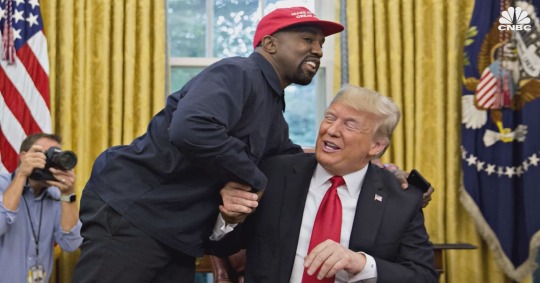
En un exemple, suite à l’attentat survenu lors de la manifestation d’extrême-droite, “Unite The Right” dans la ville de Charlottesvilles, un des extrémistes décide de forcer son passage au volant d’une voiture dans la foule de contre-manifestation.
À la suite des événements, l’ancien président déclara “Nous condamnons dans les termes les plus forts possible cette énorme démonstration de haine, de sectarisme et de violence venant de diverses parties". Ces commentaires traduisent clairement son incapacité à faire preuve de partialité en tant que président avec l’extrême-droite.
C’est tout ?
Non, lors de la Fashion Week de Paris en octobre 2022, notre Kanye internationale a jugé judicieux de se vêtir d’un t-shirt avec inscrit “White Lives Matter” afin de s’opposer au mouvement de lutte pour les droits des noires, “Black Lives Matter”. Tout ceci, aux bras de Candace Owens, conservatrice et proche de Donald Trump également Afro-américaine, comme quoi l’expression qui se ressemble, ça s’assemble prend tout sans sens.

Les noirs vs Kanye West ? :
Énormément de célébrités dénonceront ses propos et actes envers la communauté noire, telles que Snoop Dogg, Chris Evans et récemment Gigi Hadid. Son ami de longue date, Jay-Z et sa femme Beyoncé lui tournerons également le dos de nombreuses fois pour ces raisons.
Mais c’est sans compter sur le commun des mortels qui lui montrera de plus en plus un détachement et de l’agacement pour ces propos incohérents à répétions. En plus de dénoncer ses propos, davantage de personnes noires ont montré une indifférence et froideur face à ces mésaventures extérieures aux polémiques énoncés plus haut, telles que son divorce avec star de télé-réalité Kim Kardashian.
Kanye West et son rapport à Dieu :
Revenons à un aspect important de la vie de Kanye, d'après ses récents états d’âmes, la religion. En effet, Kanye West s’est souvent considéré comme un Dieu vivant, mais sa récente conversion au christianisme, le fait se repositionner comme un servant du Christ. Il existe dans la bible de nombreux verses suggérant aux Chrétiens d’imiter Jésus en ayant au cours de leur vie une conduite similaire à lui lors de son passage sur terre. “Et c'est à cela que vous avez été appelés, parce que Christ aussi a souffert pour vous, vous laissant un exemple, afin que vous suiviez ses traces” 1 Pierre 2.21.
La théorie :
En effet, la pratique d’une religion nous permet parfois d’avoir une vision différente du monde qui nous entoure ou d’interpréter certaine dimension de la société d’une manière discordante des autres. C’est ce qui a sûrement été le cas de Kanye West.
Comme vous le savez ou non, Jésus était Juifs et une des raisons pour laquelle, il était détesté par ses semblables, était sa prétention incompatible avec la Loi. En effet, selon les Juifs, Jésus devait être puni, car il se proclamait comme étant le fils de Dieu, ce qui était considéré comme un blasphème selon eux. “À cause de cela, les Juifs cherchaient encore plus à le faire mourir, non seulement parce qu’il violait le sabbat, mais parce qu’il appelait Dieu son propre Père, se faisant lui-même égal à Dieu” Jean 5.18.
Les Juifs voulaient la mort du Christ, mais l’imaginaire collectif est persuadé que ce sont eux-mêmes qui ont accompli l’acte de le crucifier. Or, il s’agit des conséquences d’une condamnation des romans dirigeants de la région de Judée couvrant à l’époque Israël. Les romans ne supportaient pas l’idée qu’une potentielle personne puissante, puisse leur reprendre la gouvernance de cette région. Par son charisme et ses nombreux disciples, Jésus était, à ce moment, la personne, la plus susceptible d’acquérir cette gouvernance.

Le Christ étant quant à lui une personne de paix, il a pu, par la suite établir un climat de paix avec les Romains en leur affirmant ne pas prétendre à cette position de gouverneur d’État. De leur côté, les prêtres Juifs continuaient de contester le positionnement de Jésus qui demandait l’arrêt des impôts pour “Dieu” qui était versé en réalité aux prêtres comme source de revenus.
Ce qui lui vaut une condamnation par Ponce Pilate, alors gouverneur romain en Judée, par peur de perdre sa place et la domination romaines alors “acceptée” par les Juifs à ce moment. Cela n’empêche pas que la mort de Jésus reste selon la Bible la prophétie découlant du christianisme. “Car Dieu a tant aimé le monde qu'il a donné son Fils unique, afin que quiconque croit en lui ne périsse point, mais qu'il ait la vie éternelle” Jean 3.16.
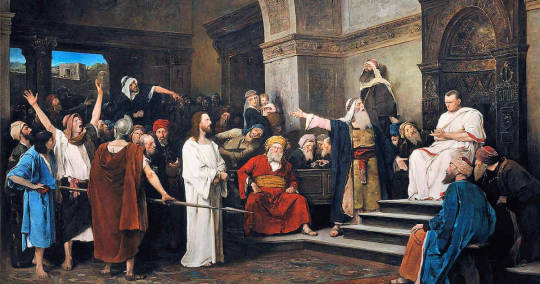
Conclusion :
La dernière polémique en date de Kanye West et qui résulte du boycott quasi total du rappeur est dû à une accumulation de propos antisémites durant le mois d’octobre 2022. En effet, suite à son port du t-shirt avec l’inscription “White Lives Matter” survenu le même mois, il semblait judicieux à Ye d’enchaîner sur une nouvelle polémique.
L’accumulation de ces déclarations par Kanye ne serait pas anodines, effectivement, il se pourrait qu’il souhaite se positionner en tant que victime de la société et en un Jésus crucifié des temps modernes.
Le reniement de la communauté noire :
Si on observe bien, tout au long de sa carrière, Kanye a souvent dénoncé à sa manière le positionnement des noirs dans la société, voir renier son appartenance à la communauté noire en raison de ses incompatibilités de vision de l’évolutionnisme avec celle-ci. Ce qui lui a valu un reniement plus ou moins important de la communauté au cours des dernières années et durant cette dernière polémique. Ce qui pourrait être comparable dans le cadre de cette théorie, du rejet des Juifs de Jésus.
La condamnation des Juifs :
Secondement, son attaque en vers la communauté Juifs serait selon lui une manière de mettre en lumière un aspect de la société par une idéologie antisémite qui serait la monopolisation de la parole des Afro-américains par les Juifs en raison de leur possession de la plus part des industries et marchés. Ye est sûrement conscient qu’il se fera plus rapidement mettre en pâture après une accumulation de propos antisémites. Boycott semblable à la condamnation de crucifixion émise envers Jésus par les romains.
L’observation des autres :
Un aspect n’a pas été soulevé durant cette théorie : les fans, les médias, l’opinion des personnes non noires et non juives dans cette polémique. Une neutralité et un positionnement en tant que spectateur des conséquences des récents propos de Kanye West est observable de la part de ces derniers. Il est sûr que face à ces polémiques, Ye a sûrement perdu une partie de ses fans, mais sûrement pas la totalité de ceux-ci comme il est observable par le maintien du nombre de ses followers sur les réseaux sociaux et une baisse plus ou moins importante, mais pas non plus affolante de ses streams à hauteur de 23%. Ce qui est souvent observable dans le phénomène de la cancel culture où très rarement la personne “cancel” subit un boycott total incluant également la totalité de ses fans. Lors de polémique de ce niveau, un silence des fans est fréquemment observable, car il serait mal vu de revendiquer son appréciation à ce moment-là. On pourrait donc positionner ces derniers et surtout ses fans comme les Juifs disciples de Jésus, devenu Chrétien à sa mort et par la suite, livrés à eux-mêmes.
Simple polémique ou problème de société ? :
Bien que cette analyse ne reste qu’une théorie, ces polémiques soulèvent également énormément de questions sociétales. Telle que la banalisation d’idéologues antisémites afin de justifier les dysfonctionnements économiques et sociaux qui peuvent être parfois digne de doctrines nazies établies dans l’inconscient collectif. Mais également de la capacité des multinationales à prendre des mesures de boycott rapide uniquement lorsqu’elles le jugent nécessaire.
Il est effectivement notable que des mesures similaires n'ont jamais était prise contre un individu au part avant lors de propos xénophobes ou négrophobes dans ce cas là.
De plus, malgré sa multiplication de polémique, le cas de Kanye West soulève le questionnement de la tolérance 0 à certaines polémiques aux personnes de couleurs. C’est par cette question que nous terminerons, Kanye West aurait-il subi le même traitement s’il n’était pas une personne de couleur ?
#kanye west#yeezus#tmz#donald trump#blacklivesmatter#black community#afroamerican#jesus#bible#cancel culture#boycott
3 notes
·
View notes